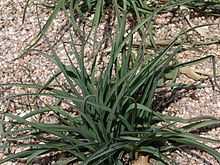Tradescantia occidentalis
From Wikipedia, the free encyclopedia
| Western spiderwort | |
|---|---|
 | |
| T. occidentalis at Denver Botanic Gardens at Chatfield State Park | |
| Conservation status | |
| Scientific classification | |
| Kingdom: | Plantae |
| (unranked): | Angiosperms |
| (unranked): | Monocots |
| (unranked): | Commelinids |
| Order: | Commelinales |
| Family: | Commelinaceae |
| Genus: | Tradescantia |
| Species: | T. occidentalis |
| Binomial name | |
| Tradescantia occidentalis (Britton) Smyth | |
| Varieties | |
|
Tradescantia occidentalis var. melanthera | |
Tradescantia occidentalis (Western spiderwort or prairie spiderwort) is a plant in the dayflower family, Commelinaceae. It is listed as a threatened species in Canada.[2]
Like in a few other species of Tradescantia, the cells of the stamen hairs of Western spiderwort are normally colored blue, but when exposed neutron radiation or other forms of ionizing radiation, the cells mutate and change color to pink.[3] Thus the plant can be used as a bioassay for radiation.
References
- ↑ "PLANTS Profile for Tradescantia occidentalis (prairie spiderwort)". PLANTS Database. USDA Natural Resources Conservation Service. Retrieved 18 December 2009.
- ↑ "Species Profile: Western Spiderwort". Species at Risk Public Registry. Government of Canada. 13 May 2009. Retrieved 17 December 2009.
- ↑ Dennis, J. A. (April 1976). "Somatic Aberration Induction in Tradescantia Occidentalis by Neutrons, X- and Gamma-radiations". International Journal of Radiation Biology (London: Informa plc) 29 (4): 323–342. doi:10.1080/09553007614550381.
.JPG)
This article is issued from Wikipedia. The text is available under the Creative Commons Attribution/Share Alike; additional terms may apply for the media files.
